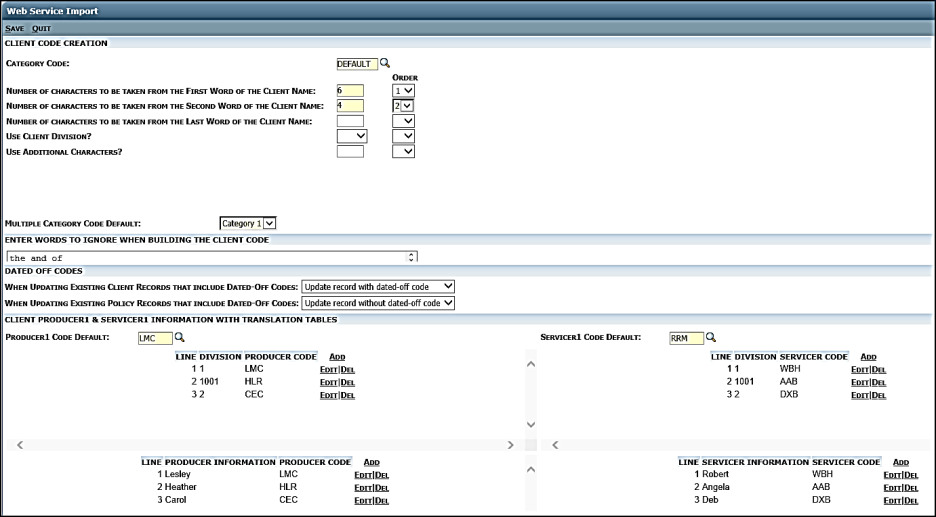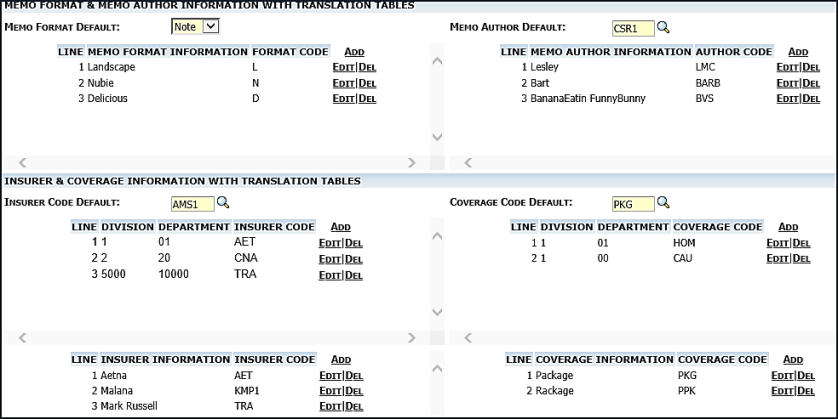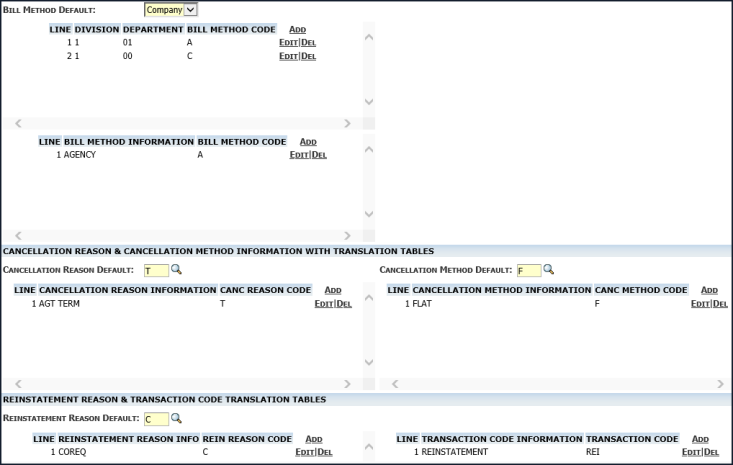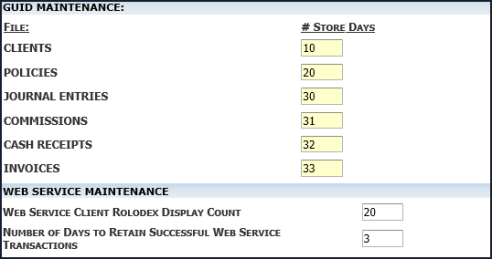Web Service Import Personalization
Web Service Import personalization was created to streamline imports from different sources. This page has multiple functions, including client code creation rules, translation tables that can be used to import codes from other systems into Sagitta codes, defaults for certain fields, and GUID tracking.
To access this page, go to Other > Personalization > Integration.
Defaults and Translation Tables
The Sagitta application has its own codes that might differ from an importing application’s codes. Default codes and translation tables allow these applications to have more successful imports.
Example – Producer
Producer1Cd is a required field in Sagitta. If the import record does not specify the first producer, the program looks to the division of the Import record to determine the producer code. Using the example settings in the picture below, if the division is 6, the producer1 code is HLR. If the division is something other than 2 or 6 the producer1 becomes LMC.
If the producer is sent but does not have a valid Sagitta code, the system compares the incoming value against a translation table. Using the example settings in the image below, if producer code LESLEY is passed, it is translated into the Sagitta code LMC. This method is used for Producers, Servicers, and Source Code for Client imports.
Personalization Field Descriptions

|
Client Code Creation |
|
|
Field |
Description |
|
Category Code |
5-digit alphanumeric field - Mandatory field. Verifies against the CATEGORIES file. The Default Category Code will appear as a mandatory field and is used if no category code is specified on the record to create a client code. |
|
Number of Characters to be taken from the First Word of the Client Name |
2-digit numeric field – Zero is a valid entry – Required field - Enter the number of characters to be taken from the first word of the Client Name when building a client code.
Note Non-alphanumeric characters (for example: %, #, @, &) are automatically ignored when building a client code. |
|
Number of Characters to be taken from the Second Word of the Client Name |
2-digit numeric field. Zero is a valid entry – Required field - Enter the number of characters to be taken from the second word of the Client Name when building a client code. Note Non-alphanumeric characters (example: %, #, @, &) are automatically ignored when building a client code. |
|
Number of Characters to be taken from the Last Word of the Client Name |
2-digit numeric field. Zero is a valid entry – not a Required field - Enter the number of characters to be taken from the third word of the Client Name when building a client code. Note Non-alphanumeric characters (example: %, #, @, &) are automatically ignored when building a client code. |
|
Use Client Division? |
Drop down list – not Mandatory. Valid options are Yes, No, and Null (No). Null is the default. Select Yes if you wish to include the client’s division in the client code. |
|
Use Additional Characters? |
Length is three (3) digits and is alphanumeric. |
|
Order field |
Drop down menu. Valid options are 1, 2, 3, 4, and 5. The order number determines how the client code is created. |
|
Multiple Category Code Default |
Required. Specify a default category code field to use if using multiple category codes to create a client code. Available options are Category 1, Category 2, Category 3, Category 4, and Category 5. |
|
Enter Words to Ignore when building the Client Code |
Free-form text field used to list the words to be ignored when building the client code (e.g., and, the, of). Note Non-alphanumeric characters (for example: %, #, @) are automatically ignored when building a client code. |
|
When Updating Existing Client Records that include Dated-Off Codes |
When the codes being imported to a client have been dated off on Sagitta, select whether to:
|
|
When Updating Existing Policy Records that include Dated-Off Codes |
When the codes being imported to a policy have been dated off on Sagitta, select whether to:
|
|
Client Producer1 and Servicer1 Information with Translation Tables |
|
|
Field |
Description |
|
Producer Code Default |
The default to use if no Producer code or Division is specified in import file. Verifies against STAFF file – Mandatory field. |
|
Servicer Code Default |
The default to use if no Servicer code or Division is specified in import file. Verifies against STAFF file – Mandatory field. |
|
Division |
Translates the Division to the specified Producer/Servicer Code. Verifies against COMPANY.MASTER file – Mandatory if LIS added. |
|
Producer Code |
Translates the Division or Producer Info code/name to the specified ProducerCode. Verifies against STAFF file – Mandatory if LIS added. |
|
Servicer Code |
Translates the Division or Servicer Info code/name to the specified Servicer Code. Verifies against STAFF file – Mandatory if LIS added. |
|
Producer Info |
Translates the Producer Info; code/name to the specified Producer Code. 50 characters max – Not case-sensitive. |
|
Servicer Info |
Translates the Servicer Info; code/name to the specified Servicer Code. 50 characters max – Not case-sensitive. |

|
Source Code, Contact Type, and Status Code Information with Source Translation Tables |
|
|
Field |
Description |
|
Source Code Default |
The default to use if no Source code or Division is specified in import file. Verifies against STAFF file. |
|
Contact Type Code Default |
The default to use if no Contact Type code or Division is specified in import file. Verifies against TYPES file – Mandatory field. |
|
Division |
Translates the Division to the specified Source/Contact Type Code. Verifies against COMPANY.MASTER file – Mandatory if LIS added. |
|
Source Code |
Translates the Division or Source Info code/name to the specified Source Code. Verifies against STAFF file. |
|
Contact Type Code |
Translates the Division to the specified Contact Type Code. Verifies against TYPES file – Mandatory if LIS added. |
|
Source Information |
Translates the Source Info; code/name to the specified Source Code. 50 characters maximum. Not case sensitive. |
|
Status Code |
Translates the Division or Status Code/Name to the specified Status Code. Verifies against the STATUSES file. |

|
Memo Format and Memo Author Information with Translation Tables |
|
|
Field |
Description |
|
Memo Format Default |
The default to use if no Memo Format code is specified in import file. Valid options: Letter, Note or Diary – Mandatory field. |
|
Memo Author Default |
The default to use if no Memo Author code is specified in import file. Verifies against Staff file – Mandatory field. |
|
Memo Format Information |
Translates the memo format type specified in the Memo file. Mandatory if LIS added. |
|
Format Code |
Translates the format code specified in the Memo file. Mandatory if LIS added. |
|
Memo Author Information |
Translates the memo author type specified in the Memo file. Mandatory if LIS added. |
|
Author Code |
Translates the author code specified in the Memo file. Mandatory if LIS added. |
|
Insurer and Coverage Information with Translation Tables |
|
|
Field |
Description |
|
Insurer Code Default |
The default to use if no Insurer code or Division is specified in import file. Verifies against INSURORS file – Mandatory field. |
|
Coverage Code Default |
The default to use if no Coverage code or Division is specified in import file. Verifies against COVERAGES file – Mandatory field. |
|
Division |
Translates the Division/Department to the specified Insurer/Coverage Code. Verifies against COMPANY.MASTER file – Mandatory if LIS added. |
|
Department |
Translates the Division/Department to the specified Insurer/Coverage Code. Verifies against COMPANY.MASTER file – ALL is a valid value and indicates that all departments within the division will be included – Mandatory if LIS added. |
|
Insurer Code |
Translates the Division/Department or Insurer Info code/name to the specified Insurer Code. Verifies against INSURORS file – Mandatory if LIS added. |
|
Coverage Code |
Translates the Division/Department or Coverage Info code/name to the specified Coverage Code. Verifies against COVERAGES file – Mandatory if LIS added. |
|
Insurer Info. |
Translates the Insurer Info code/name to the specified Insurer Code. 50 characters maximum. Not case sensitive. |
|
Coverage Info. |
Translates the Coverage Info code/name to the specified Coverage Code. 50 characters maximum. Not case sensitive. |

|
Bill Method Information with Translation Tables |
|
|
Field |
Description |
|
Bill Method Default |
The default to use if no Bill Method code or Division is specified in import file. Valid options: A (Agency) or C (Company) – Mandatory field. |
|
Division |
Translates the Division/Department to the specified Bill Method Code. Verifies against COMPANY.MASTER file – Mandatory if LIS added. |
|
Department |
Translates the Division/Department to the specified Bill Method Code. Verifies against COMPANY.MASTER file – ALL is a valid value and indicates that all departments within the division will be included – Mandatory if LIS added. |
|
Bill Method Code |
Translates the Division/Department or Bill Method Info code/name to the specified Bill Method Code. Valid options: A (Agency) or C (Company) – Mandatory if LIS added. |
|
Bill Method Info |
Translates the Bill Method Info code/name to the specified Bill Method Code. 50 characters maximum. Not case sensitive. |
|
Cancellation Reason and Cancellation Method Information with Translation Tables |
|
|
Field |
Description |
|
Cancellation Reason Default |
The default to use if no Cancellation Reason code is specified in import file. Verifies against CANCEL.REASONS file – Mandatory field. |
|
Cancellation Method Default |
The default to use if no Cancellation Method code is specified in import file. Verifies against CANCEL.METHODS file – Mandatory field. |
|
Cancellation Reason Info |
Translates the Cancellation Reason Info code/name to the specified Cancellation Reason Code. 50 characters maximum. Not case sensitive. |
|
Cancellation Reason Code |
Translates the Cancellation Reason Info code/name to the specified Cancellation Reason Code. Verifies against CANCEL.REASONS file – Mandatory if LIS added. |
|
Cancellation Method Info |
Translates the Cancellation Method Info code/name to the specified Cancellation Method Code. 50 text characters. Not case sensitive. |
|
Code |
Cancellation Method Code. Verifies against CANCEL.METHODS file – Mandatory if LIS added. |
|
Reinstatement Reason and Transaction Code Translation Tables |
|
|
Field |
Description |
|
Reinstatement Reason Default |
The default to use if no Reinstatement Reason code is specified in import file. Verifies against REINSTATE.REASONS file – Mandatory field. |
|
Reinstatement Reason Info |
Translates the Reinstatement Reason Info code/name to the specified Reinstatement Reason Code. 50 characters maximum. Not case sensitive. |
| Invoice Default Pre-Fill for Payee, Producer and Transaction |
Where to get Payee, Producer, and Transaction information if not sent in the invoice import file. Mandatory field. Options are:
|
| Invoice Options – Generate Output for Agency Bill? | Options are blank (no), Yes, and No |
| Invoice Options – Default User Staff Code for Output | The default to use for invoice output. Verifies against STAFF file – Mandatory field. |
| Invoice Options - Send Invoice Output To: |
The default user role type to send invoice output. Options are:
|
| Invoice Options – Incoming Staff Code to Staff Code for Output | User to receive invoice output based upon the code in the invoice import file. Verifies against STAFF file. |

GUID Maintenance
Globally Unique IDs (GUIDs) are used to ensure records are not imported more than once. A GUID is required for every record imported. Importing 1000 clients requires 1000 GUIDs, one GUID per client record. The purpose of the GUIDs is to ensure that the same import batch is not duplicated.
You can specify the number of days a GUID is stored. A record exists of when an import was done. Using the information from the image below, GUIDs from an import of client records remain on the Sagitta database for 10 days.

If an import is run twice before the GUID has been removed from the system, the web service returns the following error:
Code = 999
Message = GUID: 400 has already been processed. ImportBlock has not been imported.
|
Web Service Maintenance |
|
|
Field |
Description |
|
Web Service Client Rolodex Display Count |
Numeric only, 1 – 9999, not required. For methods RolodexContains, and RolodexStartsWith Displays up to the number designated of clients that meet the search criteria. |
|
Number of Days to Retain Successful Web Service Transactions |
Numeric only, 0 – 999, not required. Retains Successful and Non-Fatal Error transactions in the Web Service Transaction Log in Sagitta. |